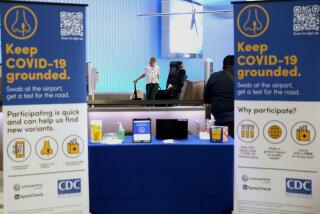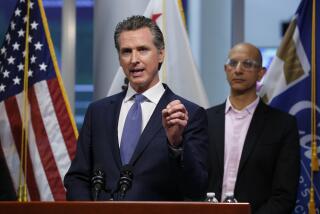Newsom rescinds California’s COVID-19 state of emergency, marking an end to the pandemic era

- Share via
SACRAMENTO — California’s COVID-19 state of emergency officially ends Tuesday, bringing a symbolic close to one of the most challenging chapters of state history and of Gov. Gavin Newsom’s political career.
The Democratic governor declared the state of emergency three years ago, giving himself broad executive powers to protect Californians from an unpredictable and deadly virus. After previously resisting GOP pressure to end the emergency as conditions improved, Newsom now says California is finally ready to move forward.
“California is better prepared and that’s because we have a serious Legislature and the health ecosystem in California is second to none in the country,” Newsom said.
The governor proclaimed a state of emergency March 4, 2020, at a time when there were only 53 known cases of COVID-19 in California.
Anticipating rapid spread of the virus that could overwhelm hospitals, the proclamation gave the governor the legal authority to make, amend and rescind state regulations, suspend state statutes and redirect state funds. The emergency declaration also allowed Newsom to commandeer private property, including hospitals, medical labs, hotels and motels.
Although the pandemic solidified Newsom’s legacy as a crisis governor, his use of power opened him up to scrutiny from across the political spectrum. His decisions to enact mask and vaccine mandates and ever-shifting restrictions on businesses and everyday activities turned him into a GOP caricature of oppressive Democratic rule.
Newsom was spotted dining with lobbyist friends at the posh French Laundry restaurant in Napa Valley after advising Californians to avoid mixing with other households, leading to headlines across the country and criticism of him as a hypocritical leader.
After a Sacramento County Superior Court judge granted more time to gather petition signatures because of the pandemic, Republicans forced a vote to recall the governor the following year. Critics also seized on the fact that Newsom’s children were attending classes at a private school while millions of California public school children were forced into distance learning programs from home.
Newsom handily defeated the recall campaign, but the French Laundry misstep frustrated even his staunchest supporters. Meanwhile, leaders in his own party at times criticized his decisions.
“I think Gov. Newsom, like pretty much everybody else in California, is really sick of dealing with COVID,” said Jack Pitney, a professor of American politics at Claremont McKenna College.
California’s chief executive has been careful to avoid declaring victory over the virus, but in June 2021 he proclaimed at a reopening celebration at Universal Studios that the state was ready to “turn the page.” Later that year, another wave of the virus led to more restrictions.
California currently has the 11th lowest COVID-19 death rate per capita in the country, according to data compiled by The Times. The California Department of Public Health also reported this year that the state breached 100,000 deaths as a result of the virus.
Newsom recently said that his administration set the groundwork to end the state of emergency last year when he called off most of the remaining restrictions and began transitioning into a plan to live with the virus. The governor added that California is moving in the same direction as the Biden administration, which announced plans to let the federal coronavirus public health emergency expire May 11.
The change won’t make much of a difference in the daily lives of most Californians but could eventually affect the cost of and access to treatment and preventive services.
California law requires health plans to cover the cost of COVID-19 therapeutics and vaccines and, until November, reimburse the cost of at-home tests. Starting in early November, drugs and tests will be covered only if obtained from providers in patients’ insurance networks.
The situation is slightly less clear for the uninsured, who should be able to access the government’s stockpile of COVID-19 drugs and vaccines until at least this summer. Federal government officials have said the Biden administration is seeking to ensure that supplies remain available beyond that time.
Robert Wachter, chair of UC San Francisco’s Department of Medicine, warned that any policy changes that make it more difficult for the uninsured to access free COVID-19 care, testing or vaccinations could pose health equity problems and as a result increase the threat of contracting COVID for all Californians.
“If you have a situation where more people are sick, feel sick, don’t know what they have, potentially are going into work and exposing themselves to other people and probably should be on Paxlovid, but don’t have access to it, that’s all bad,” Wachter said. “In a perfect world, that wouldn’t happen.”
In preparation for the end of the emergency, Newsom called for new legislation to allow nurses to continue to dispense COVID-19 therapeutics and for laboratory workers to solely process COVID-19 tests. Assemblyman Marc Berman (D-Menlo Park) introduced legislation to do that under AB 269, which passed the Assembly earlier this month and is expected to come up for a vote on the Senate floor this week.
The governor, accused by conservatives of abusing his powers, noted that California is ending its state COVID emergency while Republican-led Texas is not.
Texas is one of seven states with an emergency declaration still in place. And similar to Newsom, Gov. Greg Abbott has been reluctant to give it up because of the broad powers he’s granted under an emergency declaration, said Randy Erben, an adjunct professor at the University of Texas School of Law and a former legislative director for Abbott.
After initially requiring masks in indoor public places from July 2020 until the following March, Abbott changed course months later and has used his emergency powers to prevent cities and counties from instituting their own mask requirements and vaccine mandates.
Although Newsom and Abbott took divergent paths, Erben said Abbott was “absolutely excoriated by the conservative right” for his early mask rules. Unlike the criticism Newsom received from the GOP over restrictions and mandates, Abbott’s carried the added pressure of coming from within his own political party.
“I have every bit of sympathy for any chief executive of a state during the COVID pandemic,” Erben said. “I just think there was no winning. And I think that what they did in the beginning, and I’d say this about anyone, was heroic, and they took huge political risk in a time where nobody knew what the right answers were.”
More to Read
Sign up for Essential California
The most important California stories and recommendations in your inbox every morning.
You may occasionally receive promotional content from the Los Angeles Times.











